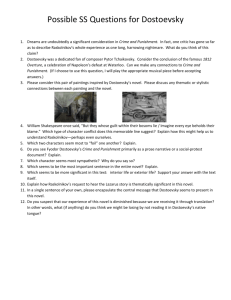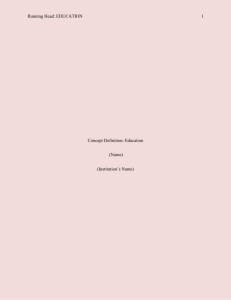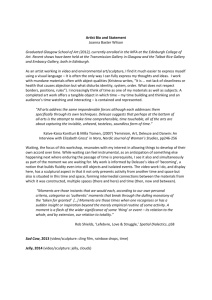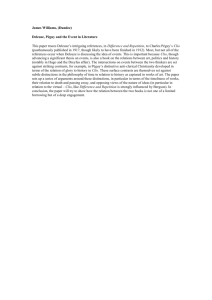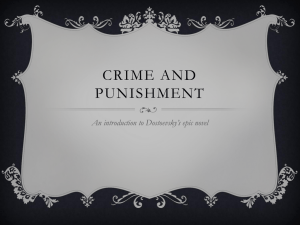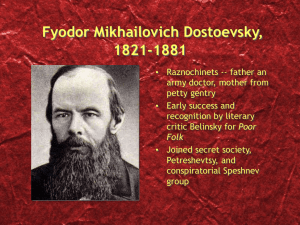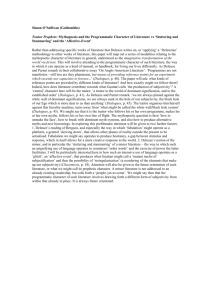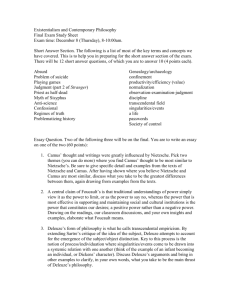The contemporary critic struggles to understand the idea of the
advertisement
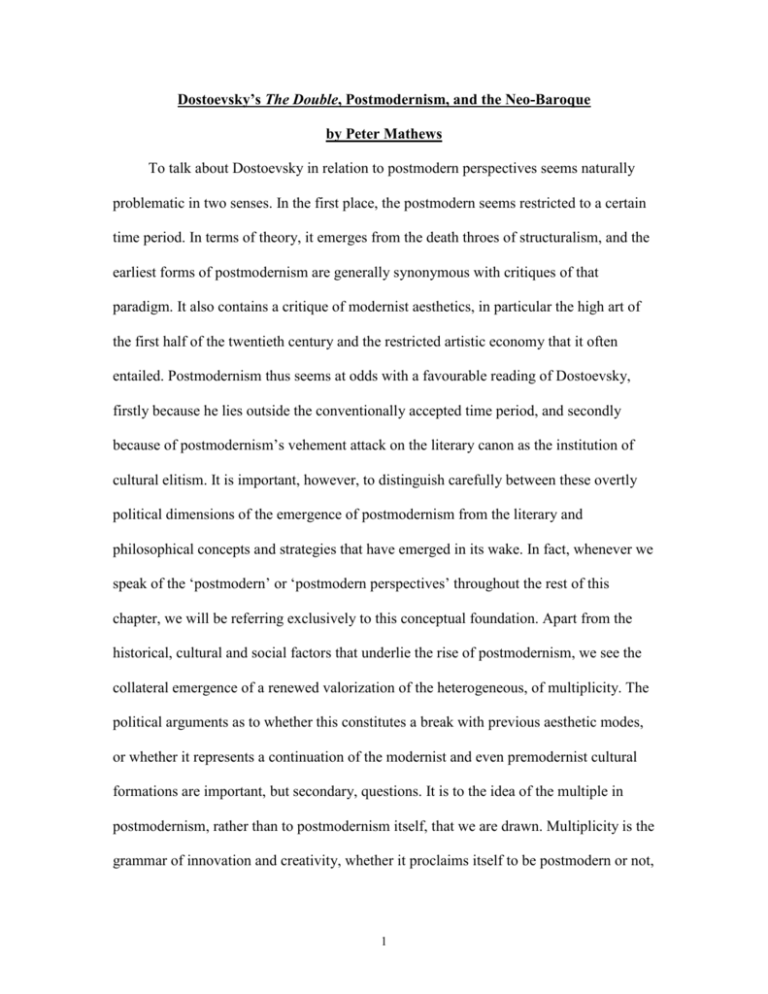
Dostoevsky’s The Double, Postmodernism, and the Neo-Baroque by Peter Mathews To talk about Dostoevsky in relation to postmodern perspectives seems naturally problematic in two senses. In the first place, the postmodern seems restricted to a certain time period. In terms of theory, it emerges from the death throes of structuralism, and the earliest forms of postmodernism are generally synonymous with critiques of that paradigm. It also contains a critique of modernist aesthetics, in particular the high art of the first half of the twentieth century and the restricted artistic economy that it often entailed. Postmodernism thus seems at odds with a favourable reading of Dostoevsky, firstly because he lies outside the conventionally accepted time period, and secondly because of postmodernism’s vehement attack on the literary canon as the institution of cultural elitism. It is important, however, to distinguish carefully between these overtly political dimensions of the emergence of postmodernism from the literary and philosophical concepts and strategies that have emerged in its wake. In fact, whenever we speak of the ‘postmodern’ or ‘postmodern perspectives’ throughout the rest of this chapter, we will be referring exclusively to this conceptual foundation. Apart from the historical, cultural and social factors that underlie the rise of postmodernism, we see the collateral emergence of a renewed valorization of the heterogeneous, of multiplicity. The political arguments as to whether this constitutes a break with previous aesthetic modes, or whether it represents a continuation of the modernist and even premodernist cultural formations are important, but secondary, questions. It is to the idea of the multiple in postmodernism, rather than to postmodernism itself, that we are drawn. Multiplicity is the grammar of innovation and creativity, whether it proclaims itself to be postmodern or not, 1 and so we are drawn inexorably to texts, such as Dostoevsky’s, which possess this quality. The most conspicuous work of Dostoevsky’s oeuvre that engages with this key concept is his early novel The Double (1846). In approaching Dostoevsky from a postmodern standpoint, we do not wish to downplay the influence of his contemporaries. Indeed, as we have argued elsewhere, a movement such as French realism, which raises questions about the problematic relationship between truth and literature, is a key precursor to the debates about postmodern perspectives in literature and art.1 Thus we can confidently declare that the influences on Dostoevsky’s early fiction are consonant with our project rather than as a historical aside. The nightmarish qualities of some of his early fiction – The Landlady and The Double in particular – can be traced back to the tales of the German writer E.T.A. Hoffmann, for example. But it is well known that Dostoevsky’s literary interests, apart from encompassing such fellow Russians as Pushkin and Gogol, were focused on the great French writers of the early nineteenth century. We can point here to the two ‘founding fathers’ of French realism, Stendhal and Honoré de Balzac (Dostoevsky, of course, worked on translations of Balzac’s work), as well as the American expatriate Edgar Allan Poe (Dostoevsky wrote a preface for a Russian translation of three of his tales). Poe’s impact is ubiquitous in The Double. There are allusions, for example, to Poe’s story “The Purloined Letter” (1844) in Chapter 13: But to his astonishment the letter was not in his pocket….Mr Golyadkin began to tremble like a leaf at the thought that his undeserving twin, having somehow got wind of the letter from Mr Goldyakin’s enemies, had flung his Notes 1 This is a key argument from my PhD thesis, which is a study of Stendhal (forthcoming). The title of the thesis is The First Step. 2 coat over his head with the express purpose of purloining it. ‘What’s more, he’s purloining it as evidence,’ thought our hero, ‘but why evidence?’.2 When facing his superior in Olsufi Ivanovich a few pages later, the narrator once again tells us that the “thought of the purloined letter came into his mind”.3 The story of the purloined letter resurfaces famously in the work of the preeminent post-structural psychoanalyst Jacques Lacan. But, more to the point, Poe himself is a pioneer of the doppelganger story: his tale “William Wilson” (1839) similarly tells of a man who is haunted by his exact double. Another obvious point of convergence between Dostoevsky and the French is the key analogy of the mirror. In the most famous passage of Scarlet and Black (1830), Stendhal puts forward what appears to be the realist notion that “a novel is a mirror journeying down the high road”4, and its echo is again heard in Poor Folk (1846) when Devushkin writes: “Literature is a picture, or rather in a certain sense both a picture and a mirror”.5 Stendhal’s analogy launches a discussion about the limits of literary representation, from the “azure blue of heaven” to the “mire in the puddles on the road below”.6 The mirror, of course, is the precondition for the concept of the double in Dostoevksy’s own novel, and on the very first page Golyadkin, blissfully ignorant of what is to befall him, checks himself in the mirror: As soon as he sprung out of bed he ran to the small round mirror standing on his chest-of-drawers. Although the sleepy, short-sighted, rather bald figure reflected in the glass was of such an insignificant character that nobody at all would have found it in the least remarkable at first glance, its owner was evidently quite satisfied with what he saw there. ‘It would be a fine thing if something was wrong with me today, if a pimple had suddenly 2 F.Dostoevsky, Notes From The Underground/The Double, Harmondsworth: Penguin, 1972, p.274 ibid., p.282 4 Stendhal, Scarlet And Black, Harmondsworth: Penguin, 1953, p.365 5 F.Dostoyevsky, Poor Folk And Other Stories, Harmondsworth: Penguin, 1988, p.52 6 Stendhal, Scarlet And Black, p.365 3 3 appeared out of the blue, for example, or something else disastrous had happened; however, for the moment, it’s all right, for the moment everything is going well.’7 Golyadkin’s moment of prescience is paralleled in Stendhal’s novel. The novel’s hero is a poor peasant named Julien Sorel, and at this moment in the story he has just moved up in the world by obtaining a tutorial position at the house of the town’s mayor. On his way to the mayor’s house he stops at the local church. On the ledge of the prie-dieu, Julien noticed a scrap of paper, with printing on it, lying there flat as if it were meant to be read. He cast a glance at it and saw the following words: Details of the execution and last moments of Louis Jenrel, executed at Besançon on... The paper was torn. On the other side were the first words of a line which read: The first step... Who could have put this paper there? thought Julien. Poor wretch! he added with a sigh, his name ends just like mine...8 Julien heralds his own imminent downfall just as Golyadkin does. For ‘Louis Jenrel’ does not merely sound like ‘Julien Sorel’, they are in fact scrambled versions of each other: Louis Jenrel is the double of Julien Sorel. The contemporary critic struggles to understand the idea of the double from the perspective of the nineteenth century, that is, as a moment of the fantastical, as a lingering and malignant manifestation of the dark side of the soul. Between us we have the translucent membrane of Freudian thought in which the romantic interpretation of the double undergoes its ultimate disenchantment. Freud incorporates the double into the field of rational thought, into the consciousness that so often loses its way in the labyrinth that is the Dostoevsky narrative. A significant example from Freud is the dream of Irma’s injection, the most famous dreams of modern times, the dream of the master himself: the dream of Irma’s injection. There he dreams of not one, but three doubles: 7 F.Dostoyevsky, The Double, pp.127-128 4 I at once called Dr M., and he repeated the examination and confirmed it….Dr M. looked quite different from usual; he was very pale, he walked with a limp and his chin was clean-shaven….My friend Otto was now standing beside her [Irma, that is], and my friend Leopold was percussing her through her bodice and saying: ‘She has a dull area low down on the left’.9 As Freud goes on to explain, Irma is one of his psychoanalytic patients. The three others who perform the medical examination, and who then proceed to inject her with a dirty needle are, he claims, displacements of his own ego. Freud’s motive here is to propound his thesis that the fundamental function of dreams is to fulfill unconscious wishes. His wish in this dream, strangely, is not to cure Irma at all, but rather to protect the validity of his psychoanalytic theories. Freud argues that the dream of Irma’s injec-tion represents an unconscious fantasy that Irma’s continuing troubles are not related to a failure of his psychoanalytic technique, but are instead the result of a medical condition. The three doubles in the dream – Dr M., Otto and Leopold – ensure this is so by injecting her with a dirty needle. The question we must put to Freud, and which is already imminent in Dostoevsky’s texts, is: is there only one double, or several? In The Double, the reader is presented with what appear to be two manifestations, distinguished for us by the narrator as Golyadkin ‘senior’ and ‘junior’. But as the dream of Irma’s injection shows, the double is capable of multiplying, fragmenting and tearing the fabric of reality even further. The Wolf Man’s dream, for example, increases the figure to a sum of six or seven wolves or doubles. In A Thousand Plateaus, Gilles Deleuze and Félix Guattari press the question beyond these limits. They point us back to Freud’s extended essay, “The Unconscious”, which he published in 1915, a year after the Wolf Man case. In that essay, Freud explores the 8 Stendhal, Scarlet And Black, p.45 5 differing psychical structures that characterize the clinical conditions of psychosis and neurosis. In the case of neurosis, he says, the patient is able to understand the difference between a metaphor (Deleuze and Guattari’s example is a sock) and its deeper psychical meaning (its hole-like shape suggests a vagina, pointing back to the neurotic’s Oedipal desire for the mother). The psychotic, by contrast, grasps the metaphor not as the sock, but as a “multiplicity of stitches”, an entire “field of vaginas”.10 Comparing a sock to a vagina is OK, it’s done all the time, but you’d have to be insane to compare a pure aggregate of stitches to a field of vaginas: that’s what Freud says….No sooner does Freud discover the great art of the unconscious, this art of molecular multiplicities, than we find him tirelessly at work bringing back molar unities, reverting to his familiar themes of the father, the penis, the vagina, Castration with a capital C…(On the verge of discovering a rhizome, Freud always returns to mere roots.)11 When we broach the question of the double, then, Deleuze and Guattari’s criticism points us away from the idea of there being a simple interplay between a dyad of terms. Indeed, in Dostoevsky’s novel the fragmentation has already taken place, but it remains barely noticeable until we examine the novel more closely. In the first place, when Golyadkin first encounters his double, he chances on not one but three strangers on his crazed flight home from the scene of his humiliation. The first simply comes towards him and passes him by, then disappears into the snowstorm. A few moments later, another – and who cannot, by his proximity to the first, be identical to him – approaches Golyadkin: In front of him, about fifteen yards away, the small black figure of a man hastening towards him was again visible. The man was hurrying, scurrying, almost running; the distance between them rapidly decreased. Mr Golyadkin was even able to examine the new belated passer-by closely – and when he S.Freud, The Interpretation Of Dreams, Harmondsworth: Penguin, 1991, p.182. The ellipses are Freud’s. G.Deleuze and F.Guattari, A Thousand Plateaus, Minneapolis: University Of Minnesota Press, 1987, p.27 11 ibid. 9 10 6 did so, he exclaimed aloud in horrified bewilderment; his knees shook. It was the same pedestrian, the one already known to him, the one he had made way for ten minutes earlier, who had now suddenly and startlingly appeared in front of him again.12 Golyadkin, approaching this second figure, tries to pursue him through the city streets, but succeeds only in attracting yet another double. Again, this third manifestation points to another double rather than to the reappearance of the first two, since after Golyadkin has chased the second double the third appears running in the same direction as the hero, as if he, too, is chasing these other doubles. Dostoevsky therefore sets up from the beginning the possibility that there is more than one double, and the only thing that obscures this multiplicity is the narrative unfolding of the story from the privileged persepective of Mr Golyadkin ‘senior’. The appearance of the three doubles, of course, confounds a conventional psychoanalytic reading of the double. A typical strategy might be to consult Freud’s paper “The Uncanny”, an essay which, fittingly, looks at Hoffmann’s fiction. Freud’s central argument there is that what is experienced as the ‘uncanny’ is something that is already familiar to the subject, but reappears differently because it has been repressed. The repressed object has, as it were, sneaked past the guard of the superego, imbuing it with an eroticism that is at once seductive and horrifying. The famous closing sentences of Chapter 5 of The Double point towards this: The unknown, also still in hat and overcoat, was sitting before him, on his own bed, with a slight smile on his lips; narrowing his eyes a little, he gave him a friendly nod. Mr Golyadkin wanted to cry out but could not, to make some sort of protest but his strength failed him. His hair stood on end and he collapsed into a chair, insensible with horror. Mr Golyadkin had recognized his nocturnal acquaintance. Mr Golyadkin’s nocturnal acquaintance was none other than himself, Mr Golyadkin himself, another Mr Golyadkin, but 12 F.Dostoyevsky, The Double, pp.169-170 7 exactly the same as himself – in short, in every respect what is called his double…13 In addition to the three ‘others’ that he encounters on his return journey, Golyadkin meets a fourth double on returning home. Perhaps he meets the same double four times, although the narrative suggests that this is physically improbable. A standard psychoanalytic interpretation, therefore, would have to argue that, in order for there to be four doubles, the reality of the narrative is not a concrete reality but rather a psychical reality, that the episodes that Golyadkin experiences take place in a ‘virtual reality’, and as such are hallucinations. The various manifestations are explicable because they are a function of Golyadkin’s fevered mind. The double is therefore presented to us the feature of Golyadkin’s neurosis, the repetitive symptom that ultimately points us back to the death drive. We do not want to discard the idea that Dostoevsky is one of the pioneers of the eminently postmodern practice of blurring the boundaries between reality and signification. The distinction, however, must be drawn between the psychoanalytic notion of ‘psychical reality’ and the postmodern concept of the ‘virtual’. The distinction emerges from the Deleuzian critique of psychoanalysis in Difference and Repetition, even before the collaborations with Guattari on Capitalism and Schizophrenia, and is indicative of Deleuze’s ability to shake the prevailing suppositions about literature and philosophy, including his often very different vision of what the postmodern signifies. Once again we return to the division set up between the double and multiple doubles. In The Fold Deleuze states explicitly that all perception is hallucinatory, but that the question of how this idea plays itself out is the key issue. In Descartes, in Kant, and once again in Freud, 13 ibid., p.173 8 the idea of repetition is one of returning to an original source, a pragmatic Platonism in which the ‘latent content’ is substituted for the ‘Form’. But, according to our Deleuzian reading, there is no such ‘form’ in Dostoevsky’s novel. Events fold into one another in a manner that defies the classical notion of sufficient reason. The multiple Golyadkins are like gremlins – molecular devils, if you like – in the machinery of the plot. The reader is regularly subjected to the same bewilderment as Golyadkin by certain events that unfold in the course of the novel but whose motivation is unclear. The subplot concerning the German woman that Golyadkin is supposed to have seduced, for example, is conducted in complete obscurity from the reader. The novel also possesses Kafkaesque overtones; when he talks to his manservant Petrushka about hiring a carriage, he is astonished that his plans for a secret rendezvous are already known. “The world is full of rumours,” replies Petrushka, “We know everything, sir…”.14 Just as telling are Dostoevsky’s ironic references to the cultural status of the novel as an art form. The novel, it must be remembered, has only made its mark as an artistic form in the course of the last two centuries. Its production in the eighteenth century was still synonymous with decadence and loose morality, and the French word ‘romanesque’ (‘novelistic’) was equated with a ludicrous romanticism. The figure of Jean-Jacques Rousseau and his phenomenally successful novel Julie, or The New Heloise became an icon of this double standard during the nineteenth century, and authors such as Balzac delighted in parodying him in the same manner that Cervantes had caricatured the romantic code of chivalry two hundred years earlier. Thus Golyadkin rails against what he sees as the negative influence of the romanesque upon the attitudes of the German woman: 9 Would you have me behave like somebody in a silly novel, come to some near-by hill-slope, dissolve in tears at the sight of the cold indifferent walls that imprison you, and finally follow the example of certain bad German poets and novelists, and die, is that it, madam? But first allow me to tell you, as a friend, that that’s not the way things happen, and secondly you, and your parents too, would be soundly whipped if I had my way, for giving you French novels to read: for you learn nothing good from French novels. They are poison, rank poison…nowadays, in our individual age, madam, tender words are not in fashion; the days of Jean-Jacques Rousseau are past.15 Clearly the irony with which Dostoevsky imbues the fictional narrative, and the textual paradox is foregrounded when Golyadkin, as the novel’s protagonist, claims that he is not acting like a character in a fiction. The Double, in this sense, has all the hallmarks of the (post)modernist anti-novel. Echoing similarly sardonic statements by the French realists about the verisimilitude of the text (such as Stendhal’s counterclaim, in his essay on Sir Walter Scott, that “art is a pretty lie”), the narrator of The Double repeatedly asserts that this is an “utterly veracious story”.16 Moreover Golyadkin is referred to throughout as “our hero”, another Quixote-like parody in the sense that Golyadkin possesses no heroic qualities whatsoever. His passivity makes him one of the ultimate ‘unheroic heroes’ - to use Raymond Giraud’s designation - in canonical literature. Golyadkin’s protest against the romanesque as both a cultural cliché and an illusion (“that’s not the way things happen”) is further undercut by his own recourse to hackneyed shibboleths about justice and submission to authority. When he appeals to his colleague Anton Antonovich, for example, he spouts an almost incoherent stream of conservative clichés: “I’m not a free thinker of any kind, Anton Antonovich, I shun all kinds of free thought…this is right thinking, really good, and you will like to hear it…I am far from a free-thinker. I accept the benevolent authorities as a father to me. The benevolent 14 15 ibid., p.262 ibid., pp.276-277 10 authorities, it’s said, make this or that statement, it’s said, and you, it’s said, must…a young man must do his duty…”.17 Faced with a new, explosive moment of heterogeneity, Golyadkin falls prey to hysteria and attempts at every turn to homogenize the emergent multiplicity. The narrative technique of distinguishing Golyadkin ‘senior’ and ‘junior’ pretends to veil this multiplicity, but in such a way that its duplicity is obscured but not hidden. Dostoevsky’s distinction functions in the same way that a mask conceals the identity of its wearer but does not hide the fact that an act of concealment is taking place. Golyadkin ‘junior’ stands in for a potentially infinite field of doubles, we have argued, but at the same time this unravels the false psychological unity of the original Golyadkin. In fact, it is this interplay between genuine and counterfeit that drives the novel. At the beginning Golyadkin is anchored firmly to his world and, although an “insignificant character”, he is nevertheless “quite satisfied”.18 In spite of this, numerous hints are made about the ambiguity and fluidity of his identity even before the appearance of the doubles in Chapter 5: the division between the dream world and the actual world, for example; the careful grooming of himself in the mirror; the prescient musings about ‘not being himself’ that day. When out in his carriage, he crosses paths with Andrey Philippovich and avoids speaking to him, thinking that he can pass off the snub as if “it’s not me but somebody else strikingly like me”.19 As the tables are turned with relentlessly, Golyadkin asks: “[B]ut which is the fowler here and which is the bird? That’s another question, 16 ibid., p.157 ibid., p.246. All ellipses, with the exception of the first and second, are Dostoevsky’s. 18 ibid., p.127 19 ibid., p.132 17 11 gentlemen!”.20 The ambiguity breaks through this veil of innuendo when the Golyadkins face each ‘other’ off at work: this was another Golyadkin, a completely different one, and yet at the same time very like the other – of the same height and build, dressed in the same way and with the same bald patch – in short, nothing, absolutely nothing, was lacking to complete the resemblance, so that if they were taken and placed side by side nobody, absolutely nobody, would have taken it upon himself to say which was the old and which the new, which was the original and which the copy.21 The logical totality of the narrative, wobbling precariously since the novel’s opening, finally fragments at this point. The sign ‘Golyadkin’ is fluid, one might say ‘leaky’, in the sense that the entropy of that sign leaves behind an infinite and forever multiplying field of doubles. Golyadkin replays the scenario of the sorcerer’s apprentice, but this time the chopping action is directed against himself, and in fact the reader is told several times of the “annihilation” of Mr Golyadkin, who nevertheless, impossibly, continues to live and act. Let us return to the central question of this chapter: is there a single double, or are there several, a multiplicity? The division into ‘senior’ and ‘junior’, into “original” and “copy”, is blurred by Dostoevsky in The Double. The action of the text takes place in a hallucinatory field, the field of the unconscious, but the appearances of the doubles do not constitute a repetition in the sense of the eternal return of the same. Deleuze and Guattari argue that Freud makes this mistake by failing to recognize the fundamental multiplicity of the unconscious; where there is a crowd of doubles, he hears only a single person.22 The critique of repetition as the eternal return of the same, for instance, is the centerpiece of Difference and Repetition. There Deleuze distinguishes “two types of repetition: one 20 21 ibid., p.148 ibid., p.177 12 which concerns only the overall, abstract effect, and the other which concerns the acting cause. One results from the work, but the other is like the ‘evolution’ of a bodily movement….in the dynamic order there is no representative concept, nor any figure represented in a pre-existing space. There is an Idea, and a pure dynamism which creates a corresponding space.”.23 Deleuze seeks to repudiate the notion that repetition is simply a recurrence, an identity, by proposing a new way of conceiving difference, through the notion of “pure difference”. With pure difference, repetition shifts from being the eternal recurrence of the same to the eternal return of the different. The idea of pure difference is most aptly set out for us in The Fold, Deleuze’s study of Leibniz. There the question of pure difference is broached in the context of theology. Deleuze refutes the stereotypical view of Leibnizian theology, popularized and vulgarized by the much quoted ‘God chooses the best of all possible worlds’. A more productive way of looking at Leibniz’s theology, he argues, is to look at how it responds to the increasingly powerful attacks on both classical reason and the proofs for the existence of God which proceed from that controversy. Leibniz differs from previous and subsequent defenders of the existence of God. In contrast to Descartes (who precedes him) and Kant (who succeeds him), Leibniz does not resort to a single, transcendental principle in order to accomplish his theistic rescue mission. In fact, argues Deleuze, he does the opposite. In the Leibnizian mode of thought, he writes, there is a radical agglomeration of principles, stretched out to infinity. The true character of the Leibnizian game…is first of all a proliferation of principles: play is executed through excess and not a lack of principles; the game is that of principles themselves, of inventing principles. It is thus a game of reflection, of chess or checkers, where skill (not chance) replaces 22 23 G.Deleuze and F.Guattari, A Thousand Plateaus, pp.29-30 G.Deleuze, Difference And Repetition, London: Athlone, 1994, p.20 13 old gifts of wisdom or prudence….it is a game of filling holes, in which emptiness is imagined and where players refuse to give way to absence… You don’t capture your adversary in order to reduce him to absence, you encircle his presence to neutralize him, to make him incompossible, to impose divergence upon him. The Baroque is just that, at a time just before the world loses its principles. It is the splendid moment when Some Thing is kept rather than nothing, and where response to the world’s misery is made through an excess of principles, a hubris of principles, and a hubris inherent to principles.24 It is precisely this infinite multiplication of principles that institutes the notion of pure difference. Repetition of the same is precluded because repetition is at every point a new, idiosyncratic beginning-again, a singularity that has never appeared before but takes its place from among an infinite set of compossible variations or ‘folds’. Deleuze’s example of chess is a good one, in so far as the chess player repeats a set of structured rules during the course of every game. However, in the midst of this repetition, pure difference is at play within the “body without organs” that constitutes the chessboard; no two games of chess are alike, and even if a repetition of the same were attempted by mechanically retracing the moves of a previous game, this would itself constitute a recontextualization and hence an implicit difference and distancing from the ‘original’. The line of intersection between Deleuze’s postmodern philosophy and The Double is the idea of subjectivity (or, more correctly, subjectivities) that proceeds from this notion of pure difference. For when Deleuze writes in The Fold about “having a body”, his thought connects with Dostoevsky’s own ideas about “having a fictional character”. Deleuze talks about “the body” as a “zone of clarity”, a vague and inexhaustible space that is constituted by an infinity of bodies. These parts, these other bodies, are made up in 24 G.Deleuze, The Fold: Leibniz And The Baroque, London: Athlone, 1993, pp.67-68 14 turn of a multiplicity of bodies, “crowds of monads”, that retreat into infinity like the magnifications of a Mandelbrot set.25 Monads that have a body must be distinguished, and monads that are the specific requisites of this body, or that belong to parts of this body. And these second monads, these monads of bodies, themselves possess a body that belongs to them, a body specifically other than that whose requisites are, and whose parts in their turn possess crowds of tertiary monads. And these tertiary monads…26 How then, according to this philosophy, can we define the state of “having a body”? It is constituted, says Deleuze, by a notion of possession. Things swim in and out of the zone of clarity, things that define the body as a singularity. The problem, however, is that “it is very difficult for every one of us to make a list of our own belongings. It is not easy to know what we own, and for what length of time. Phenomenology does not suffice.”27 It is from this point of trying to define the body that we come to perhaps the most radical and interesting idea in The Fold, that of compossibility and incompossibility. We can speak of worlds – and there is an infinity of singular worlds, brought about by the multiplication of principles we spoke of earlier – and we can define these worlds in the same manner as we try to define the body. The world comes into its unique worldhood through these attributes. In one world, for example, we know that “Adam sinned”. Compossible with this is one of Leibniz’s other famous examples, that “Caesar crossed the Rubicon”. Now, a second world might be a world in which Adam does not sin. Clearly this world is incompossible with the first, since it would be paradoxical to have a world in which Adam is both a sinner and not a sinner. A third world might consist of both an Adam who does not sin and a Caesar who does not cross the Rubicon, and so on. 25 ibid., p.108 ibid. 27 ibid., p.109 26 15 The point of this logical game, for Leibniz, was to prove that we live in the best of all possible worlds. From this proceeds his theistic argument that God exists, since the best of all possible worlds and atheism are, according to Leibniz, incompossible. Although Deleuze does much to salvage Leibnizian philosophy and the Baroque sensibility from so-called “rationalist” interpretations, and despite hailing it as one of the great predecessors of his own postmodern perspectives, he recognizes this limit of the incompossible, visible here in Leibniz’s theological proof, which ultimately presents a barrier to multiplicity. Deleuze argues, however, that the revolutionary nature of the Baroque is not lost, but continually reemerges throughout subsequent literature and philosophy in the form of a neo-Baroque sensibility. Of course, he does not mean that these new formations necessarily look back to the historical Baroque, rather that they engage with its fundamental questions. Thus the nineteenth century French poet Stéphane Mallarmé is presented by Deleuze as an exemplary instance of the neo-Baroque. Alongside Mallarmé, Deleuze places Samuel Beckett, and we cannot but add Dostoevsky to this list. The point of contention between the Baroque and the neo-Baroque (we include the postmodern as a form of the neo-Baroque, according to Deleuze’s definition) is certainly this notion of the incompossible. Leibniz uses it, in the end, as a tool to block multiplicity by turning it into a theological proof. But it is here that the notion of pure difference gives us its most cogent examples. Mallarmé’s poem A Throw of the Dice (once again, closer to an anti-poem), for example, is made up of words and small phrases, apparently chosen at random (by a throw of the dice, we might say) that have been scattered across the page. A Throw of the Dice represents a collapse of the incompossible: instead of being thrown 16 once in a singular and exclusive gesture, the arbitrariness of language crowds together as a multivalent difference in itself. Dostoevsky’s novel performs a similarly radical critique of the incompossible. Let us recall one of Leibniz’s examples: Adam sinned in this world (the best of all possible worlds), and therefore an Adam cannot simultaneously exist in this world that did not sin. Parallel to this example is the figure of Golyadkin in The Double. Golyadkin regards his double as a teratology, a monstrous perversity of nature, and appeals to the natural order in the same way as he appeals to the ‘benevolence’ of the authorities. This underground narcissism is betrayed in the awful moment of the “Judas kiss”, when the two Golyadkins embrace, in a bizarre gesture of friendship, in front of their colleagues: “There was a ringing in Mr Golyadkin’s ears and darkness before his eyes: he imagined that an endless string of Golyadkins all exactly alike were bursting in through all the doors of the room; but it was too late….The resounding treacherous kiss had been given, and…”28 Once again there is not a single double but several, appearing and reappearing in an eternal return of the different. The “Judas kiss” is prefigured earlier in the novel by Golyadkin’s dream: with every step he took, every time his foot struck the pavement, there sprang up, as if from under the ground, another exactly and completely identical Mr Golyadkin, revolting in his depravity. And all these complete replicas, as soon as they appeared, began running along behind the other, stretching out in a long file like a line of geese and scurrying after Mr Golyadkin, so that there was no escaping perfect counterparts of himself, so that horror deprived the much-to-be-pitied Mr Golyadkin of breath, so that finally there had sprung up a terrible multitude of perfect replicas, so that at length the whole capital was clogged with perfect replicas and a policeman, seeing such a disturbance of the peace, was obliged to take all the perfect replicas by the collar and put them in a lock-up that happened to be handy …29 28 29 F.Dostoyevsky, The Double, p.284. The ellipses are Dostoevsky’s. ibid., pp.230-231 17 Golyadkin’s dream, the ‘point de capiton’ of our argument, is certainly the most stunning example of this fragmentation, this emerging multiplicity in Dostoevsky’s text. “Our hero” seems to finally ‘fold in’ on himself, to at last remove his hands - if only for a few moments - from his ears so as to take in the full scope of the polyphonic choir. Our postmodern perspective on Dostoevsky draws to a close by noting an explosion of new perspectives, weaving in and out of the fabric of the text. The double exists not as a once-off freak of nature, but as an entire field of doubles, of Golyadkins who are never quite sure, in their state of having a fictional character, what “belongings” they possess. In the conclusion to The Fold, Deleuze heralds the collapse of the incompossible, the dawn of a new set of movements and moments of capture, and the shift from Leibnizian “monadology” to a (postmodern) “nomadology”.30 “We are discovering new ways of folding, akin to new envelopments,” writes Deleuze, “but we all remain Leibnizian because what always matters is folding, unfolding, refolding.”31 It is in this sense we are bringing Dostoevsky ‘into the fold’, no longer in the Christic connotation of the word, but in this Deleuzian, postmodern perspective; not a single fold, but several. 30 31 G.Deleuze, The Fold, p.137 ibid. 15th April – 8th May 1999 18
